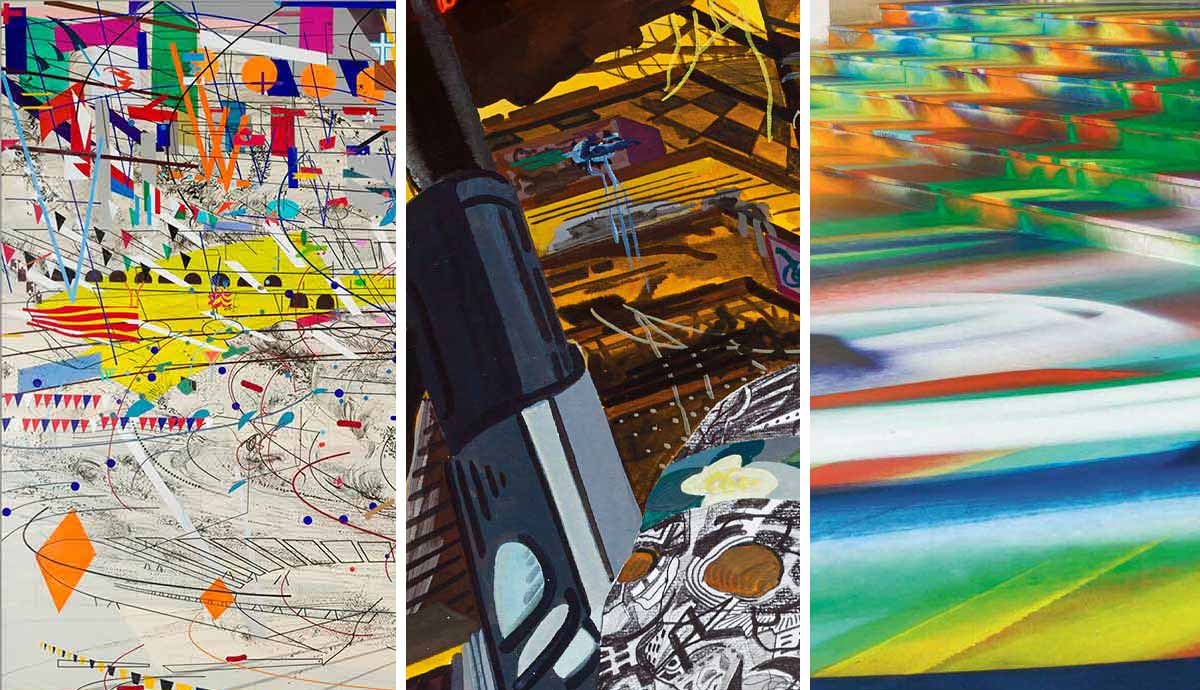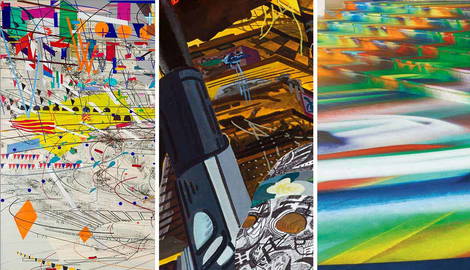
Abstract art is now more than 100 years old, and it is now widely recognized as an integral aspect of modern and contemporary art. Throughout this time, abstract art has cycled through a huge variety of styles, mediums and methods. Even today, artists continue to push the boundaries of what abstraction can be, proving there is still so much material left to explore. But how can we recognize contemporary abstract art, and distinguish it from the art of the past? We take a brief look at just some of the key characteristics of contemporary art, although there are many more beyond our list to be uncovered.
1. Digital Elements

One important aspect of contemporary abstract art that has been popular since the 1980s is the incorporation of digital or photographic elements, which give images a glossy, artificial sheen, or a synthetic, printed quality. For example, in the art of German painter Albert Oehlen, we see the playful integration of digital marks and painterly expressionism, to create an appealing mish-mash of conflicting styles.
2. New Minimalism

Minimalism emerged during the 1970s and it had a monumental impact on the development of contemporary abstract art. We can see the influence of minimalist geometry, simplicity and an emphasis on the object status of art throughout the work of many contemporary abstract artists, although they often also include messy, painterly, or hand-made elements, as a reminder that these are objects made by a human hand. One key example is the Scottish painter Callum Innes, who merges the ordered geometry of minimalism with a messy technique he calls un-painting – stripping back layers of paint with turpentine. Meanwhile the German sculptor Manfred Pernice creates higgledy-piggledy, mock-architectural constructs that merge hand-made and precise elements.
3. Vast Scales and Installations

A recent development in contemporary abstract art is the branching out into vast and unchartered scales. We see this experimentation in the work of various artists from around the world, including American painter Sam Gilliam, who covers large drapes in splatters of paint. Another prominent example is the German painter Katharina Grosse, who explores how dayglo patches of color can spread throughout entire rooms, spilling out onto windows and floors.
4. Signs and Symbols

Some of today’s abstract painters work with their own curious, codified language that involves elements of repetition, and signs or symbols resembling letters and numbers. For example, in the contemporary abstract art of American painter Jonathan Lasker we see the repetition of his own private visual language, made up of strange squiggles, lines, squares and patches.
5. Architectural Structures

In many of today’s best examples of contemporary abstract art we see the exploration of architectural structures, which are layered, distorted or deconstructed to create unusual views and perspectives, along with the invocation of abstract space. In the epic, vastly scaled paintings of American artist Julie Mehretu, lines trace the outlines of streets and buildings, suggesting three-dimensional space, but they are layered over one another to create fantastically complex arrangements that cause dizzying, disorientating effects.

Similarly, in Franz Ackermann’s weird and wonderful worlds we are drawn into deep space by perspectival lines that move towards multiple vanishing points, taking the broken world of Cubism to new heights. German painter Tomma Abts takes a subtler approach, creating strangely disquieting shallow space, with odd, unsettling colors, and shadows cast here and there in ways that make little sense.
6. The Ultimate Mess

In one strand of contemporary abstract art, some artists take the notion of expressionism to the extreme, creating what might be considered completely grotesque, asking us to think about concepts of mass consumption and excess. A key example of this school of though is German sculptor Franz West, who has made lumpy, bumpy monstrosities covered in tactile passages of paint with a strangely hypnotic, visceral appeal. Meanwhile British sculptor Daniel Silver is equally as expressive, making wildly expressive, grossly oversized, and expressively painted sculptures that look like creatures from another world.







